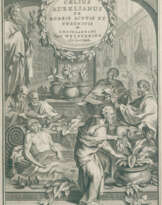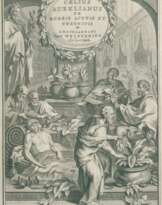ID 993239
Lot 60 | Caelius Aurelianus (fl. 5th century), Louis Jérôme Raussin (1721-1798) and others
Valeur estimée
£ 3 000 – 5 000
Five manuscripts of medical recipes, in French and Italian, on paper [France and Italy, 16th to 18th centuries]
An Italian manuscript on chronic maladies, three French pharmacopoeias, and a commonplace book containing a plethora of information - including medicinal recipes - on the running of rural properties in 18th-century Southern France.
(i) Caelius Aurelianus (fl. 5th century), Tardarum Passionum, in Latin, manuscript on paper [Italy, 16th century]. 157 x 104mm. ii + 100 + ii leaves, modern pagination in pencil, the first leaf containing verses ascribed to Rhemnius Fannius beginning 'Semioboli duplum est obulus [...]', followed by the following chapter headings, in red, from the Greco-Roman physician's Latin translation of Soranus of Ephesus' (fl. 2nd century) work on chronic and acute maladies, here left primarily incomplete, with only a few sporadic lines of actual text beneath the headings: Book I.1-6 (on headaches, epilepsy, mania, melancholia, etc.); Book II.1-9, 14 (on paralysis, ear and tooth-ache, catalepsy, etc.); Book III.1-8 (on asthma, problems of the liver and spleen, etc.); Book IV.1-8; V.1-4, 7-11 (on sciatica, arthritis, nocturnal emissions, priapism etc.), followed by an alphabetised list of diseases, pp.63-91, left largely incomplete (occasional offsetting of red ink, some light marginal staining). Modern vellum.
(ii) A pharmacopoeia, in French, manuscript on paper [France, 17th century]. 221 x 165mm. 157 pages, early pagination, containing, among others, treatments for asthma (p.1), syphilis (p.5), cough and stomach cramps (p.12), fevers (p.33), breast-pains 'pour resoudre tous maux qui viennent aux mamelles des femmes' (p.46), sciatica (p.76), gout and pox (p.100), migraines (p.115), the plague (p.152), and redness of the eyes (p.157) (some occasional foxing, the opening leaves a little dampstained). Modern quarter-vellum over marbled boards. Provenance: the opening leaf states that the recipe was given the writer by the 'apothequaire de Pierre Chatez?'.
(iii) A pharmacopoeia, in French, manuscript on paper [Southern? France, second half 18th century]. 181 x 133mm. 156 pages, contemporary and modern pagination, the text containing working doctor's notes and observations, consultations with patients and the remedies suggested, often dated between the 1750s and the 1760s, and, among others, treatments for dysentery (p.1), tooth-ache (pp.12-15), an 'excellent ointment' for gonorrhea, translated into French in 1717 from a treatise by William Cockburn (p.19), asthma (p.53), gout, a recipe given to the author by a 'Pere Reinard' on 26 May 1758 (p.60), cataracts (p.68), worms (p.71) (some marginal staining and smudging). Modern marbled binding. Provenance: one of the consultations, dated Toulouse, 1763, is signed by a 'Latour D.M.' (p.109).
(iv) Louis Jérôme Raussin (1721-1798), Recueil de formules utilises dans plusieurs hopitaux de l'Hotel de Dieu [...] Copié dessus l'imprimé par Louis Jérôme [Raussin], étudiant en medecine à Paris. A Paris, l'an de Grâce 1762, autograph manuscript on paper [France, Paris or Reims, second half 18th century]. 177 x 113mm. iii + 116 + ii leaves, complete, contemporary pagination 1-230, the work divided into three parts and describing the remedies, cures and concoctions for various ailments prepared at three different hospitals: the Hôtel-Dieu and the Hôpital de la Charité in Paris, and the Hôtel-Dieu in Reims. The cures for the second part were given to Raussin by M. Reneaume, doctor at the Hôpital de la Charité and Dean of the Faculty of Medicine in Paris, and by M. Dubois, doctor and professor at the Faculty of Medicine in Paris. The printed text apparently untraceable (some marginal thumbing). Contemporary brown calf (a little scuffed). Provenance: Louis Jérôme Raussin (1721-1798), of Reims, doctor and bibliophile: his engraved bookplate inside upper cover, and his signature on p.83.
(v) A Commonplace book, in French, manuscript on paper [Southern France, second half 18th century and early 19th century]. 189 x 144mm. 147 leaves, contemporary pagination 1-103, whereupon the book is turned upside down and the pagination continues 103-292, the texts frequently dated from the 1750s through to 1811, containing diagrams, listings of animals and furnishings in properties in Monziols etc., medicinal and practical recipes, lists of clothing, prices, accounts, measurements, construction instructions, plans, alchemical processes etc., including: an extract from lessons on experimental physics by M. L'Abbé Nolet, dated 1762 (p.1), the price of windows (p.25), the price of room furnishings in a property in Monziols, dated 1768 (p.27), measurements for a tailor (p.107), instructions on how to build a thermometer, with diagrams (p.122), the planting of buttercups, dated Labarthe 1758 (p.136), a remedy against croup (p.169), expenses incurred 'pour ameliorer mes domaines' in 1763-4 (p.190), diagrams of various types of harrows for tilling (pp.192-194), recipes for raspberry and lavender water (p.216), a recipe for an 'Elixir de longue vie' (p.248), a recipe for veau thoné (p.254), instructions, with diagrams, on how to build a furnace that can heat two contiguous rooms (p.258), prices of drugs and pharmaceutical ingredients (p.288), different recipes for ink (pp.289-290) (marginal foxing, occasional smudges). Green pasteboards (spine cracking, edges scuffed). Provenance: The Commonplace book seems to have been compiled by a M. J. Comte, who owned properties in Labarthe and Monziols, and whose grandchildren add to the notes (e.g. on p.28, dated 1805). The farm in Monziols (previously Montjoli - both versions present in this manuscript), in the commune of Massegros Causses Gorges in Southern France was built in 1702 and still stands today.
Special notice
No VAT is payable on the hammer price or the buyer's premium for this lot. Please see the VAT Symbols and Explanation section of the Conditions of Sale for further information
| Artiste: | Caelius Aurelianus (Ve siècle - Ve siècle) Louis Jérôme Raussin (1721 - 1798) |
|---|---|
| Lieu d'origine: | Europe de l'Ouest, France, Italie, Europe |
| Catégorie maison de vente aux enchères: | Manuscrits médiévaux et de la Renaissance |
| Artiste: | Caelius Aurelianus (Ve siècle - Ve siècle) Louis Jérôme Raussin (1721 - 1798) |
|---|---|
| Lieu d'origine: | Europe de l'Ouest, France, Italie, Europe |
| Catégorie maison de vente aux enchères: | Manuscrits médiévaux et de la Renaissance |
| Adresse de l'enchère |
CHRISTIE'S 8 King Street, St. James's SW1Y 6QT London Royaume-Uni | |
|---|---|---|
| Aperçu |
| |
| Téléphone | +44 (0)20 7839 9060 | |
| Commission | see on Website | |
| Conditions d'utilisation | Conditions d'utilisation |










